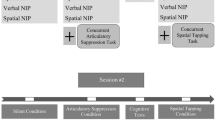Abstract
The purpose of the present work was to identify general problem solving skills that underlie the production of insight. One hundred and eighteen participants completed insight problems, analogies, series-completion problems and the Remote Associates Test. Scores on all measures were related to performance on the insight problems (Pearson r's ranged from .31 to .47, p < .008). These findings are consistent with the notion that the abilities to apprehend relations and fluency of thought are involved in insightful problem solving.
Similar content being viewed by others
References
Dewing, K. and Battye, G. (1971). Attention deployment and nonverbal fluency. Journal of Personality and Social Psychology, 17, 214–218.
Dominowski, R. L. (1981). Comment on an examination of the alleged role of “fixation” in the solution of insight problems. Journal of Experimental Psychology: General, 110, 199–203.
Dominowski, R. L. (1995). Productive problem solving. In S. M. Smith, T. B. Ward and R. A. Finke (Eds.), The creative cognition approach (pp. 73–96). Cambridge, MA: MIT Press.
Greeno, J. G. (1978). Natures of problem-solving abilities. In W. K. Estes (Ed.), Handbook of learning and cognitive processes: Vol. 5. Human information processing (pp. 239–269). Hillsdale, NJ: Lawerence Erlbaum.
Jacobs, M. K. and Dominowski, R. L. (1981). Learning to solve insight problems. Bulletin of the Psychonomic Society, 17, 171–174.
Kohler, W. (1947). Gestalt psychology. New York: Liveright Publishing Corporation.
Mednick, S. A. (1962). The associative basis of the creative process. Psychological Review, 69, 220–232.
Metcalfe, J. and Wiebe, D. (1987). Intuition in insight and noninsight problem solving. Memory and Cognition, 15, 238–246.
Ohlsson, S. (1992). Information-processing explanations of insight and related phenomena. In M. T. Keane and K. J. Gilhooly (Eds.), Advances in human thinking: Volume 1. New York: Harvester Wheatsheaf.
Schooler, J. W. and Melcher, J. (1995). The ineffability of insight. In S. M. Smith, T. B. Ward and R. A. Finke (Eds.), The creative cognition approach (pp. 97–134). Cambridge, MA: MIT Press.
Shipley Boyle, B. (1967). The shipley-institute of living scale. Los Angeles, CA: Western Psychological Services.
Smith, S. M. and Blankenship, S. E. (1991). Incubation and the persistence of fixation in problem solving. American Journal of Psychology, 104, 61–87.
Sternberg, R. J. and Lubart, T. I. (1996). Investing in creativity. American Psychologist, 51,677–688.
Weisberg, R. W. and Alba, J. W. (1981). An examination of the alleged role of “fixation” in the solution of several ”insight“ problems. Journal of Experimental Psychology: General, 110, 169–192.
Wertheimer, M. (1959). Productive thinking. Enlarged Edition. New York: Harper and Brothers.
Author information
Authors and Affiliations
Corresponding author
Rights and permissions
About this article
Cite this article
Ansburg, P.I. Individual differences in problem solving via insight. Curr Psychol 19, 143–146 (2000). https://doi.org/10.1007/s12144-000-1011-y
Accepted:
Issue Date:
DOI: https://doi.org/10.1007/s12144-000-1011-y




